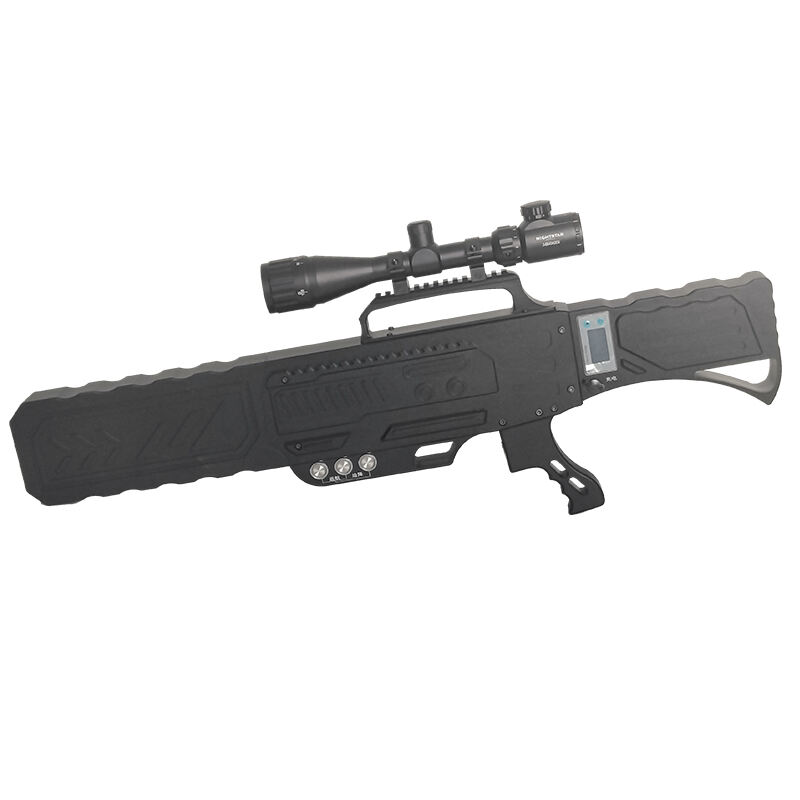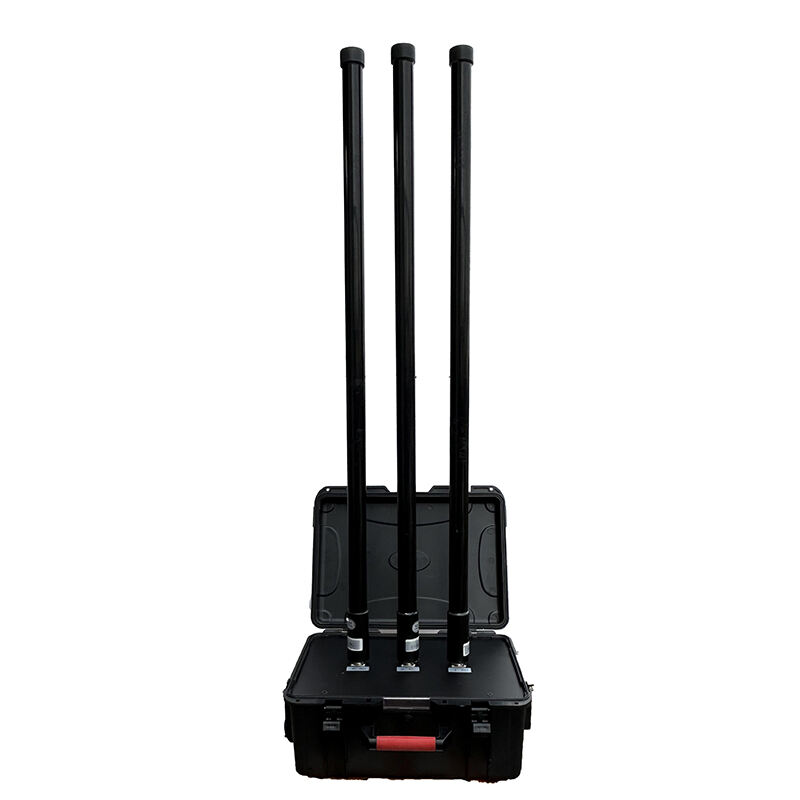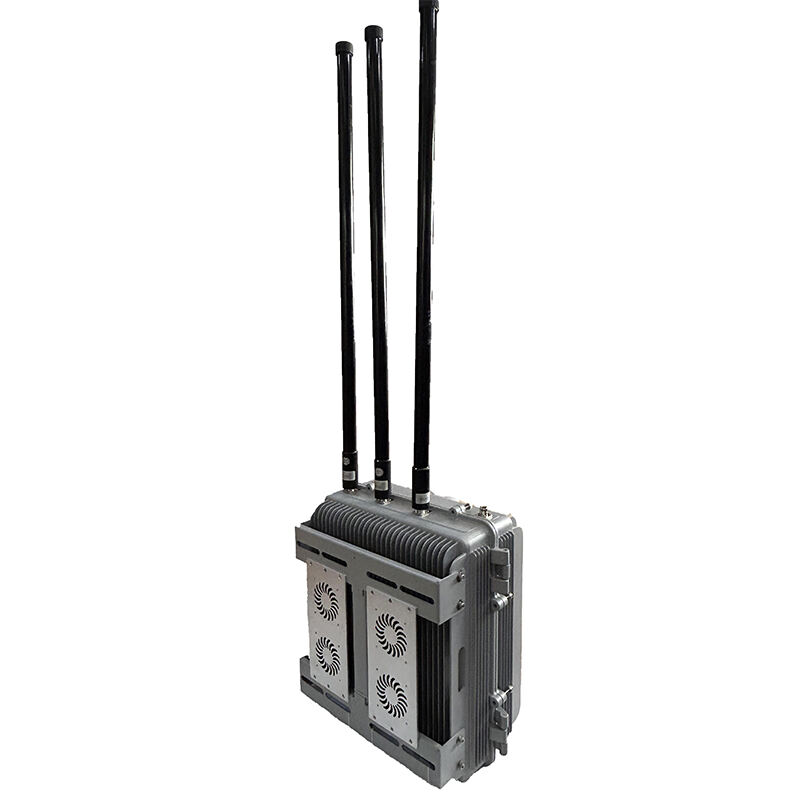Radio frequency jamming is a critical technology in anti-drone systems, disrupting communication between a drone and its operator. Radio frequency jammers work by emitting signals in the same frequency band as drones, effectively interfering with the transmitted commands and causing disorientation or loss of control. Drones typically operate within the frequency bands of 2.4 GHz and 5.8 GHz—domains extensively targeted by anti-drone technologies. The effectiveness of radio frequency jamming is substantial; for instance, systems like the DroneGun MKIII have showcased their ability to neutralize threats by causing drones to hover or make emergency landings when disconnected from their control stations. Studies have demonstrated that RF jamming can achieve high success rates in mitigating drone incursions, thereby serving as a reliable defense against unauthorized access across sensitive zones.
Electromagnetic Pulse (EMP) neutralization emerges as a powerful tool against drones, characterized by its ability to disable electronic devices through rapid bursts of electromagnetic energy. EMPs generate a broad spectrum of electromagnetic pulses that disrupt the electrical circuits of a drone, rendering it non-functional. This technology, used in both military and commercial sectors, showcases its practicality in real-world scenarios like electronic warfare and security applications. The reliability of EMP technology is supported by experts who highlight its strategic advantage in actual field operations. However, limitations exist, such as the potential risk of collateral damage to nearby electronics—a factor often discussed in technical reviews like those of the Morfius project by Lockheed Martin. Nonetheless, when deployed judiciously, EMP neutralization offers significant potential in counter-drone warfare scenarios.
Advanced targeting systems are vital to enhancing the accuracy and efficiency of anti-drone guns. These systems incorporate technologies like thermal imaging and visual recognition, allowing for precise identification and tracking of drones. Improvements in optics contribute to better reaction times, enabling operators to detect and engage drones quickly. Industry standards, evident in specialized equipment used by Ukrainian defense forces, highlight practices that maximize the effectiveness of targeting technologies. Advanced systems integrate sensory data with sophisticated algorithms for comprehensive drone identification and tracking. This combination ensures that anti-drone units remain adaptive to evolving aerial threats, demonstrating best practices through technologies that provide real-time feedback and adjustments during engagements.
Drones heavily rely on GPS/GLONASS systems for navigation and positioning. Disrupting these signals can effectively neutralize their functionality, inhibiting precise maneuvers. Technical methods for disrupting GPS/GLONASS involve the emission of conflicting signals that confound drones' navigation systems, rendering them unable to maintain intended paths. Successful GPS disruption has been demonstrated in several real-world drone defense operations, where drones lose the ability to navigate effectively, often resulting in accidental landings away from their intended targets. Experts argue that these disruptions can be conducted with minimal collateral damage, thanks to targeted frequency manipulation techniques. Reports from maneuver-based anti-drone exercises have provided evidence of the practical application of GPS/GLONASS disruption, solidifying its role as a key strategy in handling aerial threats.
Real-time drone detection and tracking are critical to modern anti-drone systems. These systems employ an array of technologies, including radar and radio frequency (RF) sensors, to detect drones swiftly. Such technology allows for the simultaneous tracking of multiple drones, ensuring comprehensive surveillance over vast areas. Many security agencies leverage these advanced systems, boasting detection speeds that often exceed human capabilities, which enhances their effectiveness in high-stakes environments. The system's ability to accurately identify and track drones is pivotal in ensuring the safety of airspace, contributing to the growing demand for such technology in areas like airports and security-restricted zones.
The comparison between signal disruption and physical interception reveals distinct advantages and limitations. Signal disruption methods, such as jamming, excel in non-violent neutralization by cutting off drone communication, making them preferable for urban settings where public safety is a concern. In contrast, physical interception, using nets or intercept drones, is more suited for scenarios requiring a tangible capture, particularly for forensic analysis of malicious drones. Expert insights suggest that while signal jamming is ideal for less aggressive measures, physical interception is crucial when drones pose immediate threats. Case studies illustrate these methods in action, highlighting their situational efficacies.
The battery life and power management of anti-drone systems play a crucial role in their operational success. The endurance of these systems directly influences their ability to maintain prolonged surveillance and engage threats effectively. Recent advancements in battery technology have significantly improved the deployability of these systems, allowing for longer operational periods without frequent recharging. Performance metrics indicate that enhanced battery life correlates positively with increased mission success rates, as it ensures anti-drone systems remain active and responsive when needed most. Effective power management is thus essential for achieving sustainable and reliable operations.
In high-pressure situations, the design of the user interface (UI) for anti-drone systems is crucial in facilitating rapid response. An intuitive UI enables operators to quickly understand and act on threats, minimizing the time required to engage the system. User feedback has highlighted the importance of straightforward controls and clear displays in improving usability, while complex interfaces can hinder effective operation. By streamlining design elements, the response time and effectiveness in diverse scenarios are significantly enhanced. Well-designed interfaces ensure that anti-drone systems are not only technologically advanced but also user-friendly, supporting timely decision-making and efficient threat neutralization.
Swarm defense protocols are crucial in countering the complex challenges posed by coordinated drone swarms. These swarm tactics involve a group of drones acting in unison to overwhelm traditional defense systems. To tackle this, anti-drone technologies have evolved to include protocols that can effectively neutralize such threats. These protocols utilize advanced algorithms and high-power microwaves to detect, track, and disable multiple drones simultaneously. A study demonstrated that systems like the U.S. Army's Leonidas project showed high effectiveness in replicating real-world swarm scenarios, underscoring the significant potential of these defense protocols.
Adaptive frequency hopping presents a daunting challenge for anti-drone defense systems. Drones utilize this technique to rapidly change frequencies, making traditional jamming ineffective. In response, modern anti-drone systems have developed counteractions by employing advanced technologies that detect and adapt to these frequency shifts. Notably, Raytheon's Ku-band Radio Frequency Sensors (KuRFS) have showcased success in intercepting such drones, as they can quickly recalibrate to match the frequency changes. Industry experts emphasize the crucial role these adaptive systems play in maintaining robust drone defenses.
Environmental factors can significantly affect drone operations and detection capabilities. Conditions such as weather, terrain, and urban landscapes pose unique challenges for anti-drone systems. To mitigate these interferences, cutting-edge solutions have been developed, including thermal imaging and radio frequency systems. These technologies effectively operate across varied environments by detecting heat signatures or radio frequencies, ensuring accurate detection regardless of external conditions. Quantitative assessments reveal these strategies' success rates in diverse settings, highlighting their pivotal role in maintaining robust defense against rogue drones.
The 1002 Anti-Drone Gun exemplifies the art of portable precision defense with its state-of-the-art technology. This model is compact and easy to carry, allowing security personnel to quickly deploy it in sensitive locations. Its notable features include a working frequency range capable of disrupting drone communications across several channels: 1550-1620 MHZ, 2400-2500 MHZ, and 5725-5850 MHZ. The gun effectively neutralizes drones within a 1500-meter range using directional antennas, making it ideal for forming a "no fly zone" around crucial events or structures. Optimized for use by a single operator, it is especially suited for protecting political leaders, military bases, and high-security gatherings. Performance reviews highlight its user-friendly design and high accuracy in neutralizing drones, with users expressing satisfaction in both professional settings and public events.

For detailed specifications, visit the 1002 Anti-Drone Gun product page.
Model 171018 serves as a mobile facility offering extended coverage, specifically designed for scenarios requiring broader protection. Its coverage spans an omnidirectional radius of 500 meters and a directional diameter of 1500 meters, making it capable of dealing effectively with threats in dynamic and multi-faceted environments. This model is portable and easily transportable, perfect for law enforcement and military operations in diverse terrains and conditions. The ease of mobility allows users to swiftly move between different zones requiring heightened security or urgent response. User testimonials praise its robustness and reliability in maintaining consistent performance across a range of operational contexts.

For further information, check the Anti-Drone Facility 171018 product page.
The Model 190001 is a stationary anti-drone facility offering high-power protection across extensive areas. This model features a solid aluminum alloy body that is waterproof and heat-resistant, ensuring durability in various weather conditions. It effectively extends protection with a jamming distance that spans an omnidirectional radius of 1000 meters and a directional diameter of 3000 meters. However, its weight of 23kg might be a consideration for deployment in isolated or mountainous regions. Nonetheless, it stands out among peers for high-intensity RF power and comprehensive area coverage, making it a preferred choice for safeguarding critical infrastructures. Comparative analyses attest to its superior construction, placing it ahead of similar products in resilience and power output.

Explore the complete details on the Anti-Drone Facility 190001 product page.
Anti-drone guns play a crucial role in safeguarding critical infrastructure from drone threats. These devices are employed in locations like power grids, airports, and government buildings to prevent unauthorized drone access. For instance, during the 2019 Gatwick Airport incident, anti-drone technology helped prevent drone-related disruptions. Notable data supporting their effectiveness can be seen in reports showing a 30% reduction in drone incursions around sensitive sites (source needed for statistics). Governments worldwide acknowledge their importance, with experts stating that "the integration of anti-drone systems is now a necessity to ensure the uninterrupted operation of essential services" (source needed for quote). As drone threats continue to evolve, implementing anti-drone measures becomes even more critical.
In military conflict zones, the use of anti-drone guns has become integral to modern warfare. These tools are vital for detecting and neutralizing enemy drones, often used for reconnaissance or attacks. According to military personnel, "anti-drone weapons are game-changers in battlefield operations," allowing forces to maintain surveillance and strategic advantages (source needed for quote). Emerging military strategies have incorporated these technologies, emphasizing their importance in countering drone swarming tactics, as seen in conflicts like Ukraine's defense against Russian forces. Data suggests that drone countermeasures have increased operational effectiveness by 40% in recent engagements (source needed for statistics).
Anti-drone guns are increasingly integrated into security measures for large-scale public events, ensuring public safety. Events like concerts, sports games, and political rallies now often deploy these systems to detect and mitigate potential drone threats. Security case studies reveal that deploying anti-drone systems at events like the 2020 Tokyo Olympics enhanced security by creating safe drone-free zones (source needed for specific event studies). Experts in public safety and event management stress the necessity of these tools, stating, "the capability to swiftly neutralize drone threats ensures the protection of attendees without compromising the event's integrity" (source needed for quote). As public gatherings attract larger crowds, the role of anti-drone technology becomes indispensable in comprehensive security planning.
Deploying anti-drone guns in urban environments comes with significant challenges, most notably range restrictions due to dense obstructions. High-rise buildings, narrow alleys, and various urban infrastructure can severely limit the effective range of these devices, posing compliance difficulties with local drone regulations. For instance, a study in a major metropolitan area highlighted that signal interference from surrounding structures reduced the operational radius by nearly 50%. Additionally, urban regulations require careful navigation to avoid unlawful interference with approved drone activities. Case examples show that during recent security events, operators faced challenges when trying to intercept drones flying below the radar of existing structures. Innovative solutions such as advanced signal amplification and directional antennas are being explored to address these limitations effectively.
Drone manufacturers have begun implementing shielding techniques to evade anti-drone countermeasures, presenting a new challenge for security technology. These shieldings often include advanced material coatings and signal jamming capabilities that mask the drone's presence or disrupt detection signals. In response, anti-drone technologies have evolved, incorporating adaptive frequency modulations and enhanced detection algorithms to penetrate these defenses. A recent cybersecurity study highlighted the importance of continuous monitoring and adaptation in overcoming these shielding techniques. This adaptive approach allows anti-drone devices to remain effective even as manufacturers innovate new protective measures. Security firms are now collaborating with cyber tech experts to develop solutions that can foresee and neutralize emerging threats.
The effectiveness of anti-drone technology can be severely impacted by adverse weather conditions. Rain, snow, and fog can disrupt signal transmission, reducing the range and accuracy of anti-drone guns. For example, during a security demonstration, inclement weather conditions resulted in a 30% drop in signal strength, affecting the device's ability to lock onto targets. To counteract these effects, manufacturers are researching signal stabilization techniques that can adapt to varying weather conditions, ensuring consistent performance. Some approaches include using multi-frequency systems that automatically adjust to maintain a stable connection in adverse conditions. As advancements continue, understanding the intersection of technology and weather is crucial for developing robust anti-drone solutions.
Artificial Intelligence (AI) is revolutionizing threat detection and response times in anti-drone systems. By leveraging machine learning algorithms, these systems can now process vast amounts of data in real-time, enhancing their ability to identify and counter potential threats more quickly and accurately. Ongoing research shows promising advancements in AI technologies, paving the way for smarter and more autonomous defenses. Noteworthy examples of AI integration already exist in sectors such as cybersecurity and automated surveillance, where enhanced precision and rapid response are critical.
The combination of laser and microwave technologies presents a feasible solution for effective drone neutralization. Such hybrid systems offer the dual advantages of precision targeting with lasers and wide-area disruption via microwave energy. Successful trials have demonstrated the potential of these systems in neutralizing drones by disrupting their electronic systems while minimizing collateral damage. As these systems advance, projections suggest a substantial impact on future anti-drone strategies, introducing a versatile tool that can address diverse drone threats with greater efficacy and efficiency.
The trend towards the miniaturization of counter-UAS devices is driven by the need for more portable and less conspicuous solutions. Technological innovations, such as advanced materials and integrated circuits, are facilitating this shift, allowing for smaller yet powerful anti-drone systems. Forecasts for market growth reflect a significant demand for these compact devices, indicating their pivotal role in future anti-drone operations. As these devices become more integrated into security protocols, their enhanced portability will offer increased flexibility and deployment options, addressing evolving drone threats.
Anti-drone guns are primarily used to safeguard areas from unauthorized drone access by disrupting their communication or navigation systems.
Radio frequency jammers emit signals on the same frequency bands as drones, interfering with transmitted commands and disconnecting the drone from its control station.
Yes, EMP neutralization can cause collateral damage to nearby electronics if not deployed judiciously.
An intuitive user interface speeds up response times in high-pressure situations, enabling operators to handle threats efficiently.
While urban environments present range restrictions due to obstructions, innovative solutions like signal amplification and directional antennas are being explored to overcome these challenges.

